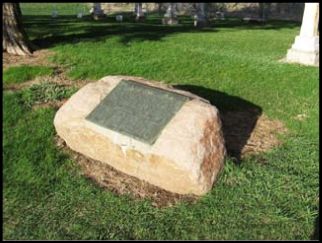 This 1938 monument in Sheffield Cemetery memorializes the Schweringen's ordeal of 1860
This 1938 monument in Sheffield Cemetery memorializes the Schweringen's ordeal of 1860Twp near the confluence of Dry creek and Bear Creek wasn't used. At that time, perhaps, the Brouhard family might have considered that cemetery as a private family burial ground and there were other facilities available nearby. As a footnote- other deaths had occurred during this time period of 1850-1875 in northwest Milford Twp and some of these burials had been down the Skunk River a long mile from Milford Mills, on the east side of the river in the very center of Sec 13 of Franklin Township.
One of the more interesting side stories about this incident is that when Mr Schweringen's estate was settled, there appeared a bill from Mr Hoover for board and room for Mr S. and Son!! Bad spelling?, a little bill padding?, or is this a completely new twist to the "official" story? If this is the case, how did the lad get to the Hoovers. Since Mr S. was blinded by the fire, did the lad supply the vision for the pair as they struggled to find some help? Did Mr S. carry the severely burned lad who would tell his Dad where to go? How did Mr S. find the Hoover farm as it would be over a slight rise and unseeable to a person a mile away to the south. The ruts of the road would be able to be followed even after a fire and if one followed the road to the northwest, after a few hundred yards of travel he might have seen the Hoover farm; but again, if Mr S. were blind, did the Hoovers see him and guide him there? Many speculations can be created.
Apparently, if the family of one adult and three children were buried the following day, the lad must have died very soon after arriving at the Hoovers. Or perhaps, if he survived a couple days, that would explain how there were conflicting reports as to how many of the children were buried at the same time with Mother Schweringen. Mr Schweringen was able to relate his unfortunate tale for several people during his stay with the Hoovers but no one whose narrative has survived has made mention of the Schweringen lad being at the Hoovers.
About a year earlier, almost to the day, a very large prairie fire had swept much of the same area and resulted in the death of a little girl in Lafayette Twp when she was caught in a backfire. This fire burned southwest, west and north of Nevada with strong winds.
Information gleaned from three different sources and paraphrased by Dale Hughes `55.
Lost in Milford Twp
Attention:
Farmers Along the
Old Diagonal Road
This little article appeared in the Dec 1863 Nevada Paper might be of interest to those current farmers living along the, now abandoned and plowed up, diagonal road leading to the Webster City area.
LOST-".....on the road leading to Pleasant Grove, Story County, a `Morrocco Pocket Book', containing from one hundred and sixty to one hundred and seventy-five dollars in cash, the principal part of which was in "greenbacks" together with other papers which were of no account to any one but the owner, besides two free passes over the G.& C.U. and C.I.& N. and C.R.&M.R. Rail Roads, one signed by E.B. Talcott (etc) ....both bearing the name of the undersigned. Any one finding said pocket book and returning the same to me or leaving it at the newspaper office, will be liberally rewarded."
GEO. F. Schoonover
Notes: No notice in later papers mentioned this pocketbook ever being returned so, perhaps, it's still along that long unused road in Milford Twp waiting to be discovered.
Geo. F. Schoonover was, for a time, the editor of the Nevada paper and was, later, a Justice of the Peace.
The G.& C.U. R.R. was the "Galena and Chicago Union".
The C.I.& N. R.R. was the "Chicago Iowa and Nebraska R.R."
The C.R. & M.R. was the "Cedar Rapids and Missouri River R.R". Through a series of consolidations these lines were formed into part of the Chicago Northwestern. These rail lines were, at the time, attempting to cross the great plains of Iowa.
Mail moved along this diagonal road once a week in each direction- northbound on Friday and southbound on Saturday. See page 310.